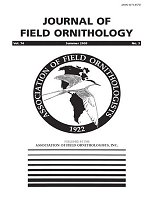Fledging success is widely used as an index of reproductive success in avian studies, but survival of young after fledging is rarely estimated. In this study, I used radio telemetry to measure rates and causes of mortality of 63 Black-fronted Terns (Sterna albostriata) in the immediate post-fledging period on the Ohau River, South Island, New Zealand, in 1998–2000. Juvenile survival for four weeks after fledging was 0.795. Mean daily survival increased from 0.972 in the first week after fledging to 0.995 in the second week and 1.00 for the third and fourth weeks. Introduced predators such as feral cats (Felis catus) and Norway rats (Rattus norvegicus) were responsible for a minimum of nine out of 12 deaths, and all except one death occurred at the natal colony prior to dispersal. Larger, heavier juveniles that fledged at a younger age tended to have higher survival after fledging, but survival could not be accurately predicted based on measurements of growth. These results indicate that the post-fledging period can be an important period for mortality in young birds, and that survival until dispersal from the natal colony is the best measure of Black-fronted Tern reproductive success currently available.
How to translate text using browser tools
1 July 2003
Does fledging equal success? Post-fledging mortality in the Black-fronted Tern
Rachel J. Keedwell
ACCESS THE FULL ARTICLE
It is not available for individual sale.
This article is only available to subscribers.
It is not available for individual sale.
It is not available for individual sale.

Journal of Field Ornithology
Vol. 74 • No. 3
July 2003
Vol. 74 • No. 3
July 2003
juvenile mortality
reproductive success
Sterna albostriata
survival




